How to Identify and Attract a Ruby-Throated Hummingbird
Updated: Mar. 15, 2024
Look for a ruby-throated hummingbird in eastern states in summer. See what males and females look like and learn how to feed them.
On This Page
What Does a Ruby-Throated Hummingbird Look Like?
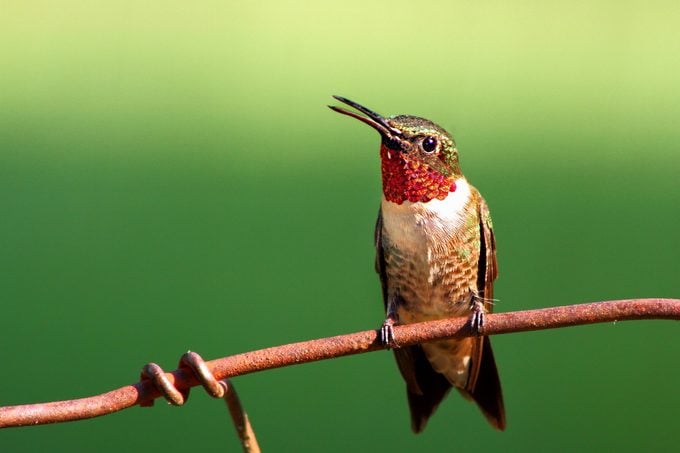
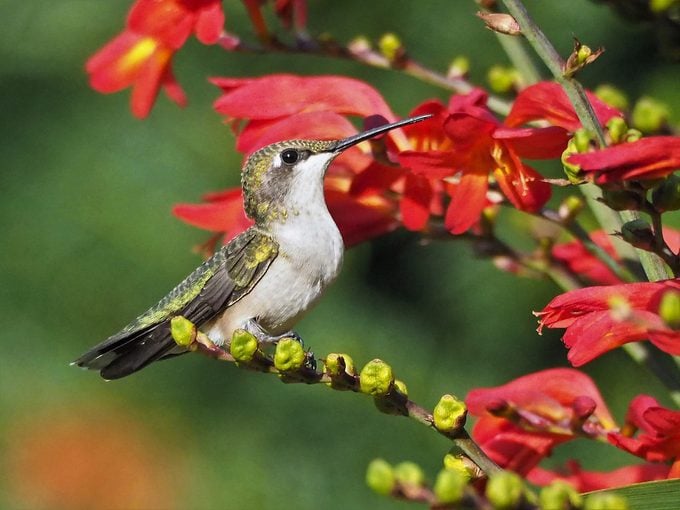
The male ruby-throated hummingbird steals the show with a green body and ruby red throat that glistens like jewels in the sunlight. Its vibrant green head glows, too! The female isn’t as grandiose in appearance. It sports a green head with white underparts and black masks near the eyes. Both sexes have a metallic green back. They measure about 3 3/4 inches long with a wingspan of 4 1/2 inches.
You need to see these stunning hummingbird pictures.
Ruby-Throated Hummingbird Nest
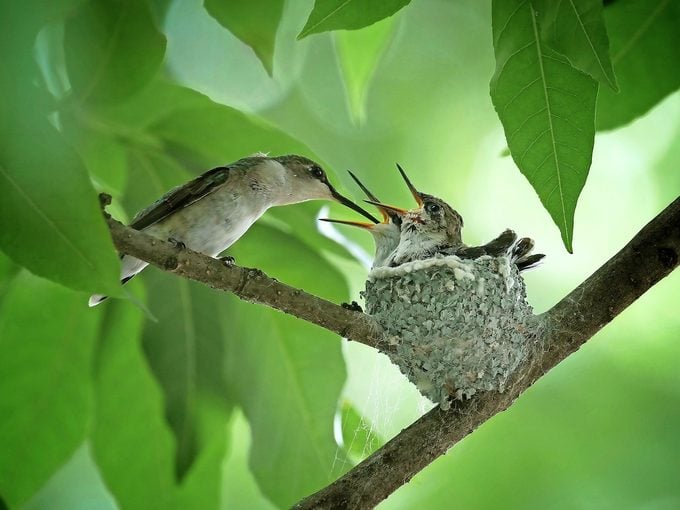
From midspring through late summer, the female ruby-throat is constantly on the move. She chooses a nest site, builds a nest, incubates eggs and raises the baby hummingbirds all on her own. The males don’t play a role. She’s doing all this while trying to keep herself fueled and fed!
These tiny fliers build a cup-shaped nest with moss, spiderwebs and camouflaged with lichen. The female lays two tiny white eggs that look like jelly beans.
Learn more about the life of a female hummingbird.
Juvenile Ruby-Throated Hummingbird
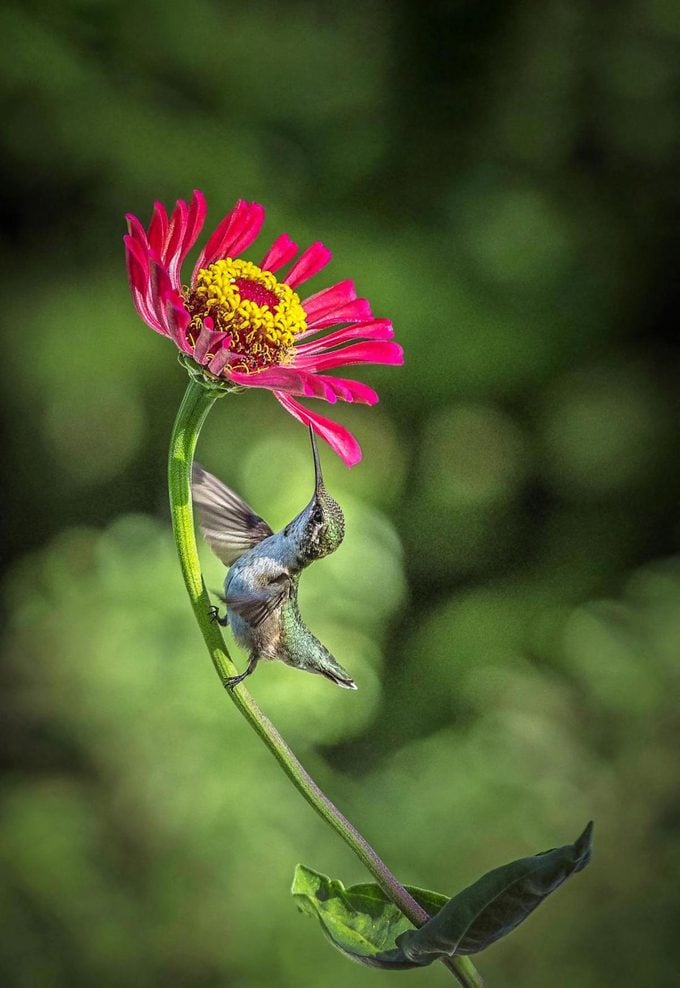
All juvenile ruby-throated hummingbirds look so similar to females that it’s often nearly impossible to tell the difference. About 15 days after hatching, baby hummingbirds stand up on the edge of the nest and exercise their wings. They leave the nest a few days later. Young fledglings can’t feed themselves; it takes practice to hover and drink nectar. The female continues to feed them for up to a week as they learn how to find food.
Whether a male, female or juvenile ruby-throated hummingbird chooses your yard, their acrobatic, territorial and erratic antics always entertain.
Check out jaw-dropping facts about hummingbirds.
What Do Ruby-Throated Hummingbirds Eat?
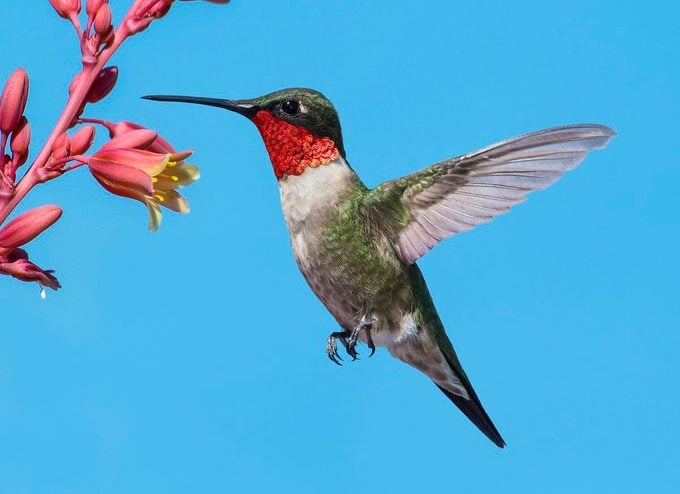
Ruby-throated hummingbirds zip, zoom and dart from one food source to another. Because they constantly burn energy while on the move, they may eat up to two or three times their body weight (which is less than a penny) in a day. Their diet consists of nectar, small insects and tree sap. Invite these teeny delights into your yard with offer sugar water and tube-shaped flowers in their three favorite colors: red, orange and pink.
Check out the best colorful hummingbird flowers to grow.
Ruby-Throated Hummingbird Call
Listen to the ruby-throated hummingbird to help identify them. This bird makes a soft “tew” and a rapid series of chipping notes.
Bird songs provided by the Cornell Lab of Ornithology.
Do hummingbirds sing? Hear the many sounds of hummingbirds.
Habitat and Range Map
Several hummingbird species are sprinkled over the western half of North America, including Anna’s and Allen’s hummingbirds. But only one, the ruby-throat, flies the eastern skies regularly. Look for them in gardens, woodland edges and parks.
Among the most common and successful hummingbirds, ruby throats are found in summer across most of the eastern U.S. and east of the Rockies in southern Canada. Their population totals an estimated 34 million birds.
Do hummingbird sightings have special meaning?
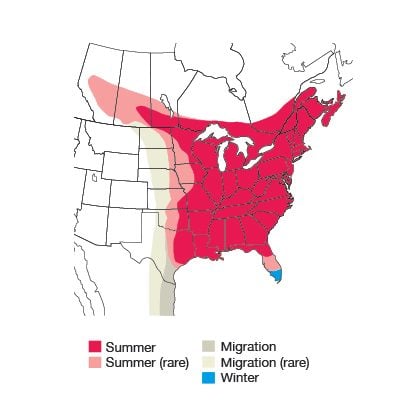
Range maps provided by Kaufman Field Guides, the official field guide of Birds & Blooms.
Ruby-Throated Hummingbird Migration
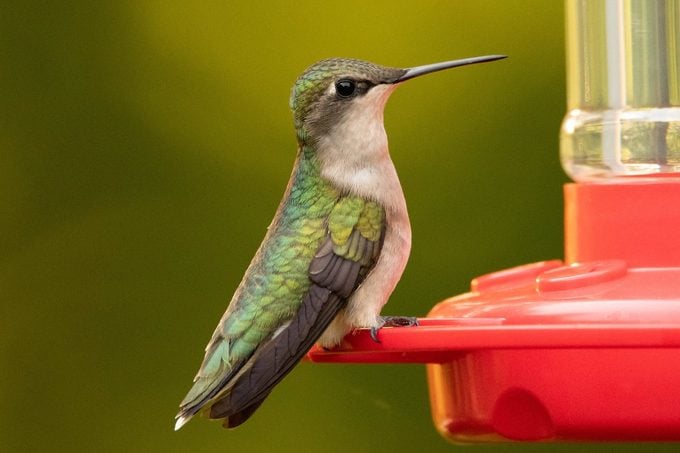
Ruby-throated hummingbirds move south in late summer and early fall. Ruby-throats may fly more than 3,000 miles from Canada to Costa Rica. And some fly nonstop 500 miles across the Gulf of Mexico during migration. That’s quite a feat for a bird that weighs a little less than 4 grams.
They need food sources to fuel their migration journey. A good rule of thumb is to leave your feeders up for a couple of weeks after you see the last one pass by.
Wing Speed and Heart Rate
These little creatures fly about 25 miles per hour and zoom even faster when the wind pushes them along. Zipping around in every direction (even backward), the nimble ruby-throated hummingbird beats its wings around 53 times per second.
When ruby-throats are really exerting themselves, their hearts race around 1,200 beats per minute. In calmer times, that rate drops to 600 beats per minute. Humans, in comparison, have a resting heart rate of about 72.
Next, find out where do hummingbirds sleep at night?
Why Trust Us
For nearly 30 years, Birds & Blooms, a Trusted Media Brand, has been inspiring readers to have a lifelong love of birding, gardening and nature. We are the #1 bird and garden magazine in North America and a trusted online resource for over 15 million outdoor enthusiasts annually. Our library of thousands of informative articles and how-tos has been written by trusted journalists and fact-checked by bird and garden experts for accuracy. In addition to our staff of experienced gardeners and bird-watchers, we hire individuals who have years of education and hands-on experience with birding, bird feeding, gardening, butterflies, bugs and more. Learn more about Birds & Blooms, our field editor program, and our submission guidelines.




















